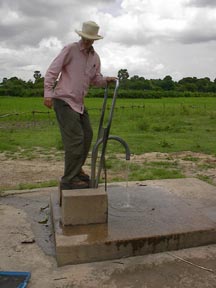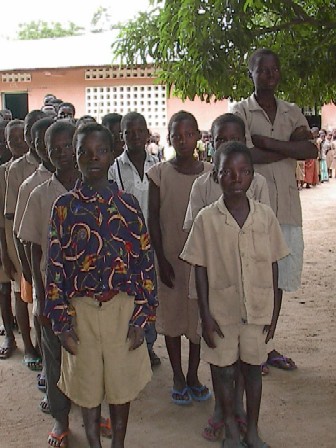Research Efforts In Benin


We have been active in the country of
A brief overview of the history of the program and
vision for its future is provided in the following pdf file (current as of
June, 2010):
Benin
Program Brief
For additional information on any of the following material, please contact:
Dr. Stephen E. Silliman
School of Engineering and Applied Science
Gonzaga University
Spokane,
Telephone:
Please
reference our group publications page for a list of
technical and educational
papers related to this project.
Relationships with
Partners in Benin
The University of Notre Dame has been fortunate in developing a close
relationships with a number of partners in Benin.
The Universite d'Abomey-Calavi in Benin: Previously known at the
Universite Nationale du Benin, UAC is the premiere national university in
Benin. Closest relationships have been developed with the Department des
Sciences de la Terre, although relationships are being developed within the
Engineering programs as well. Principally through the efforts of Dr.
Moussa Boukari and Nicaise Yalo, UAC is a key collaborator in the research we
perform in Benin, support for our field teams, and close working relationships
with our faculty and students.


Centre Afrika Obota (
Direction Generale d’Eau (previously Direction l'Hydraulique): Mr.
Felix Azonsi is our lead contact at DGEau and is the lead hydrologist for this
government agency charged with developing water supplies for rural Benin.
This extraordinary agency has provided key problem statements, logistical
support, and expert interpretation to our field results. This agency also
identified and motivated the water quality efforts in Adourekoman (below).
The Critical Focus: The people of
Benin
At the end of the day, the driving motivation for this work is the
beautiful people of Benin. These few pictures are simply a few brief
examples of these beautiful people!



We were pleased to be recognized for our work with the
Benin people via an article
Another Critical Focus: Interactions
of students
Several educational efforts have been developed in collaboration with
UAC. While we do not underestimate the impact of our technical services
in Benin (drilling wells, monitoring water quality, etc.), the impact of our
work on students in Benin and the United States is perhaps the most rewarding
focus of our efforts in Benin. Several groups of students (including
groups from both Notre Dame and Benin) have been involved in field sampling and
analysis. In addition, Dr. Silliman
has taught short courses to graduate students in Benin and Dr. Boukari
has contributed to a course in groundwater hydrology at the University of Notre
Dame. More recently, students from UND and UAC have collaborated on
research on nitrate contamination in south-central Benin and salt-water
intrusion in coastal Benin. Undergraduates from UND have also taken the lead on
an education project that has enabled teachers in Benin to use computers in the
school system and has allowed K-8 students in the U.S. communicate with
students in Benin.



Projects:
Coastal Salt
Water Intrusion
Professor Boukari has long had an interest in the hydrogeology along the southern coast of Benin with particular emphasis on the protection and management of the groundwater wells supplying fresh water to Cotonou. Over the past 15 years, these wells have shown signs of increasing salinity apparently due to recharge waters derived from Lake Nokoue. In addition, the continuing expansion of Cotonou and surrounding cities raises concern that contaminants disposed at the surface will lead to contaminated recharge to both the well field and shallow wells used by local populations not currently served by the centralized supply. Finally, the first 5 kilometers of north of the Atlantic coast represents fascinating interactions of surface water, groundwater, saline water, rainfall/runoff, and human interactions with the aquatic environment.
In response, a number of research efforts are focused on coastal Benin, including: (1) multilevel piezometers in Lake Nokoue to monitor spatial/temporal variation in recharge from this large water body, (2) geophysical (resistivity) characterization of the southern coastal zone, (3) geochemical analysis (using a manual Geoprobe direct-push device for accessing waters to depths of approximately 12 meters) of the coastal zone, and (4) groundwater modeling of the Cotonou well field, recharge from Lake Nokoue, and the hydrogeology of the southern coastal region.




Local Populations Monitoring Water Quality
Through our collaboration with DGEau,

This work has led to an interesting combination of sociological and technical
methods, including extensive interaction with the local population (see the
Master’s thesis of Pam Crane and, very soon, her dissertation). The
sociological methods have included focus group discussions, surveys, and direct
observation. The technical methods have included strip test methods as
well as colorimetry.
The population of Adourekoman, Benin, has faithfully sampled water quality in their wells now for over 6 years. Recently, the focus of the work in Adourekoman has migrated from characterization to addressing the groundwater contamination issues through the possible introduction of latrines that do not release contaminants to the subsurface. This work is being performed through joint efforts of a team of Benin and another team of U.S. students. These students are working closely with the population of Adourekoman in the hopes of securing a long-term, sustainable solution to the problem of human and animal wastes contaminating the local groundwater.


Wellhead protection for these
same villages
The efforts in Adourekoman, and the surrounding Colline Department
of Benin, have also expanded to the question of whether a combination of
numerical modeling, geophysical (resistivity) studies, and chemical tracer
tests might assist the local villages and regional water authorities in setting
priorities on land-use practices in the hopes of reducing the probability that
the water derived from groundwater wells is contaminated due to local village
activities. This work includes the
use of numerical modeling of flow in fractured media, the application of Fault
Trees and Probability Risk Assessment, and the use of resistivity and
tracer-test methods. This portion
of our work is in its relative infancy with recent efforts focused on building
inexpensive instruments to allow field-measures of the concentration of
fluorescent dyes.


Drilling of Groundwater Wells
As noted below, one of our initial motivations for groundwater work in Benin was the development of new groundwater supplies for rural villages (this motivation has changed DRAMATICALLY over the past decade!). Working closely with our partners, it became apparent that our efforts and monies were better spent helping to support a DGEau program for drilling wells (with regional drilling contractors doing the drilling and pump installation). This program is based on villages providing a relatively small cost-share, developing a water committee, going through training to select the best technology for their village, and then working with DGEau and affiliates to pursue well drilling. Within this overall structure, our program helps to identify the poorer villages that cannot afford the entire cost share. We work with these villages to help in the cost-share burden, completion of necessary paperwork, and formation of village water committees. We are currently in our second round of drilling efforts (with support received from a local private foundation and the Anne Campana-Judge Foundation) and hope to have more than 30 wells drilled and equipped with hand-pumps by the end of 2011. Landry Lougbegnon, pictured below, has been absolutely instrumental in this effort (in his role as project lead for CAO)


Analysis of Groundwater Quality
in the Fractured-Rock Region of Benin
A significant portion of the early efforts in Benin, involving both NSF
grants for research (NSF OISE 01-38238 and NSF OISE 99-78192) and an
NSF-supported REU site (NSF
To date, this analysis indicates that there are elevated Uranium concentrations
in select wells in eastern Benin. The Uranium appears to be associated
with Calcium-rich geologic settings with a general absence of Uranium has been
noted in the Silicate-rich rocks. In addition, we have looked for
groundwater contamination related to the use of pesticides in the agricultural
regions. Although this sampling has indicated an increase in the
concentration of certain major ions (e.g., Calcium and Sodium), there is no obvious
contamination directly associated with the pesticides or fertilizers utilized
in this activity. Finally, these data support identification of a
relatively stationary (statistically) distribution of groundwater quality with
major changes observed only where there are significant changes in geology.
To date, multiple reports have been completed relative to this work, including
one publication and two Master's thesis (Roope and Galbis-Reig), multiple
manuscripts (technical and educational), and a number of presentations.
Links to the publication and these reports are provided above.
The images below show some of our field experiences.

Projects: K-8 Education in
Benin and Indiana
While extensive efforts have been placed in trying to develop educational
exchanges between grade-school students in Benin and their counterparts at
local schools in Indiana, this portion of our efforts are currently on hiatus as
we assess the successes and failures of our previous efforts.
Projects: Driller Training
Driller training was an early project run through Lifewater
International (www.lifewater.org) with
support gratefully acknowledged from the West Foundation (Indianapolis,
Indiana). Performed in collaboration with CAO, this project has allowed
the villages of Houmbo (southeastern Benin) and Vovio (southwestern Benin) to
drill their own groundwater wells. The dilling is performed with an
LS-100 drill rig. Since our early
efforts in driller training, we have come to the conclusion that it is more
efficient, and the quality of the resulting well is superior, if we work with
DGEau and their water development projects to obtain new wells for needy
villages. Hence, we are no longer
pursuing driller training as a central portion of our work.
Hydrofracing in crystalline rock

An additional project, currently on hold,
involves looking for geochemical, geological, remotely imaged, or geophysical
signatures that might help guide the use of hydrofracing to improve well capacity
in the fractured crystalline rock in central Benin. For example, the well shown
above is a drilled well (the small, capped cylinder to the right of the
reservoir). The well required construction of the large reservoir so as to
increase capacity, thus allowing use of this low capacity well as a domestic
water supply. The goal of a new government project in Benin is to substantially
increase capacity of this type of well through hydrofracing. The joint research
between Notre Dame and the Universite Nationale du Benin would focus on
providing geologic, geochemical, geophysical, or remotely sensed signatures
that would help select among multiple wells competing for limited hydrofrac
capabilities.
- - -
Thanks
for your interest in our work !

